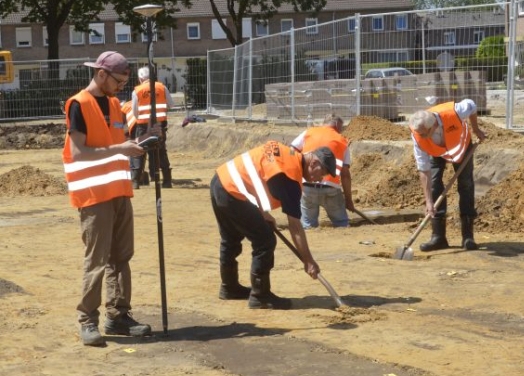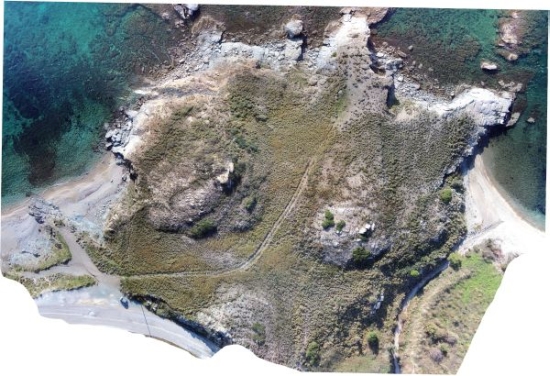
|
Digital Humanities Workbench |
Home page > Special topics > Digital archaeology > Data collection Data collection: excavationDuring an excavation, archaeological sites are investigated and stored ex situ. All finds are brought to an off-site location and non-mobilia (e.g. features [Dutch: grondsporen] and house plans) are documented so as to collect as much information as possible.
GPSDuring an excavation, a site is investigated and documented as comprehensively as possible. In most projects, research data are documented digitally in the field. Drawings are made using GPS (Global Positioning System) or RTS (Robotic Total Station). All other project documentation, such as find lists, features lists and structure lists, is entered into a database (usually Microsoft Access). The database and digital drawings are linked together and a GIS environment is created, using programs like Autocad, ArcGIS and MapInfo.
 Use of GPS during a VUhbs excavation.
DronesIn the field of archaeology, drones (also known as Unmanned Aerial Vehicles (UAVs)) are primarily used to make vertical aerial photographs of archaeologically relevant locations and regions. At the level of an archaeological excavation, for example, aerial photographs can be used to capture and clarify the layout of a site, while at a regional level, the photographs can be used for remote sensing. Compared to aerial photographs taken from a crewed plane, these drone photos are usually taken from a relatively low height, which is why they are also known as Low Altitude Aerial Photographs (LAAPs). Many modern archaeological research projects use these LAAPs in combination with photogrammetric software (see below), which can be used to generate 3D models, Digital Elevation Models (DEMs) and vertical orthophotos (geometrically corrected images that create a uniform scale throughout an image) of a site or landscape, as well as integrating it in a GIS.
 Orthophoto made for the VU project 'The sea and land routes of southern Euboia, ca. 4000- 1 B.C. A case study in Mediterranean interconnectivity'
PhotogrammetryPhotogrammetry is a technique used within archaeology to make 3D models based on 2D photographic material. The underlying technique is complicated, but the basic principle is relatively simple and is similar to the way people can see depth in the real world. Because our eyes are a small distance apart, they each register slightly different information about the world. Our brains process the separate images perceived by both eyes into a composite 3D image. Software can copy this process through certain algorithms, but they are so complicated, that a quick computer is required to perform all calculations.
Applicatons and use
PAN (Portable Antiquities of the Netherlands) Archaeological researchers have traditionally based their research on excavations, but since the rise of the metal detector, numerous private collections of ancient objects have been amassed, including collections of medieval coins, Roman fibulae (clothing pins) and prehistoric axes. The number of private finds in the Netherlands is estimated to be in the hundreds of thousands, making it a source of great importance to scientific research. PAN (Portable Antiquities of the Netherlands) is a database that systematically documents collections of private finds. PAN also includes a reference collection of (primarily) metal archaeological objects. PAN uses Linked Open Data and is linked to, among others, databases of De Nederlandsche Bank (NUMIS) and the Cultural Heritage Agency of the Netherlands. Researchers can select PAN objects based on search criteria (e.g. date, type, or function) and export them for further processing including location data.
Archaeological researchers have traditionally based their research on excavations, but since the rise of the metal detector, numerous private collections of ancient objects have been amassed, including collections of medieval coins, Roman fibulae (clothing pins) and prehistoric axes. The number of private finds in the Netherlands is estimated to be in the hundreds of thousands, making it a source of great importance to scientific research. PAN (Portable Antiquities of the Netherlands) is a database that systematically documents collections of private finds. PAN also includes a reference collection of (primarily) metal archaeological objects. PAN uses Linked Open Data and is linked to, among others, databases of De Nederlandsche Bank (NUMIS) and the Cultural Heritage Agency of the Netherlands. Researchers can select PAN objects based on search criteria (e.g. date, type, or function) and export them for further processing including location data.
Students can use PAN to determine metal finds or to plot a selection of objects on distribution maps. In the context of a tutorial, students could contribute to PAN by adding collections of finds, thereby gaining experience in documenting and determining archaeological metal finds, or by studying an item in further detail.
You can visit the PAN website at www.portable-antiquities.nl.
Reporting and information sharingAfter the fieldwork, the results must be recorded in a report. This report and the research notification are stored together in Archis. All other research data are stored in the e-depot DANS-EASY. Most of this information is freely accessible after registration. |
Other topics in this section: Introduction Preparation Data analysis |
